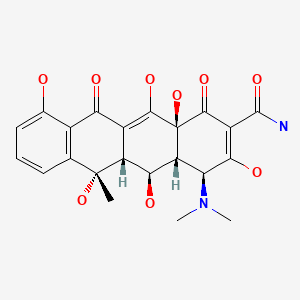CASRN: 79-57-2

Drug Levels and Effects
Summary of Use during Lactation
A number of reviews have stated that tetracyclines are contraindicated during breastfeeding because of possible staining of infants' dental enamel or bone deposition of tetracyclines. However, a close examination of available literature indicates that there is not likely to be harm in short-term use of oxytetracycline during lactation because milk levels are low and absorption by the infant is inhibited by the calcium in breastmilk. Short-term use of oxytetracycline is acceptable in nursing mothers. As a theoretical precaution, avoid prolonged or repeat courses during nursing. Monitor the infant for rash and for possible effects on the gastrointestinal flora, such as diarrhea or candidiasis (thrush, diaper rash).
Drug Levels
Maternal Levels. In an old study using a microbiologic assay, 5 women in the first week postpartum were given oxytetracycline in dosages ranging from 2 to 4 grams daily in single or divided doses. Oxytetracycline generally did not appear in milk for the first 24 hours. Concentrations then ranged from 0.25 to 1 mg/L until about a day following discontinuation of the drug.[1]
In another old study using a microbiologic assay, milk oxytetracycline levels were in an unspecified number of nursing mothers at 9 am after various dosages of oxytetracycline during the previous days. Whether they had mastitis and the time postpartum were not stated. Milk levels increased to as high as 3 mg/L after a daily dose of 1.5 grams orally for 3 days. Milk levels increased to 3 mg/L after a daily dose of 2 grams orally for 3 days.[2]
Two women were given 1.5 grams daily of oral oxytetracycline. Milk levels ranged from 0.7 to 1.1 mg/L with the peak occurring 7 hours after the dose. The authors estimated that a breastfed infant would receive 300 mcg daily of oxytetracycline in milk.[3]
Infant Levels. Relevant published information was not found as of the revision date.
Effects in Breastfed Infants
No adverse effects were noted in an unspecified number of breastfed infants whose mothers were taking oral oxytetracycline 1.5 or 2 grams daily for 3 days. Ages of the infants and extent of breastfeeding were not stated.[2]
Effects on Lactation and Breastmilk
Relevant published information was not found as of the revision date.
Alternate Drugs to Consider
References
- 1.
- Ottolenghi-Preti GF, Massironi A. Terramycin in lactation; specific method of determination. Ann Ostet Ginecol 1952;74:746-58 [PubMed: 13031337]
- 2.
- Grüner JM. The excretion of terramycin and tetracycline in human milk. Geburtshilfe Frauenheilkd 1955;15:354-60 [PubMed: 14380696]
- 3.
- Borderon E, Soutoul JH, Borderon JC, et al. Excretion of antibiotics in human milk. Med Mal Infect 1975;5:373-6
Substance Identification
Substance Name
Oxytetracycline
CAS Registry Number
79-57-2
Drug Class
Breast Feeding
Lactation
Milk, Human
Anti-Infective Agents
Antibacterial Agents
Tetracyclines
Disclaimer: Information presented in this database is not meant as a substitute for professional judgment. You should consult your healthcare provider for breastfeeding advice related to your particular situation. The U.S. government does not warrant or assume any liability or responsibility for the accuracy or completeness of the information on this Site.
Publication Details
Publication History
Last Revision: July 15, 2024.
Copyright
Attribution Statement: LactMed is a registered trademark of the U.S. Department of Health and Human Services.
Publisher
National Institute of Child Health and Human Development, Bethesda (MD)
NLM Citation
Drugs and Lactation Database (LactMed®) [Internet]. Bethesda (MD): National Institute of Child Health and Human Development; 2006-. Oxytetracycline. [Updated 2024 Jul 15].